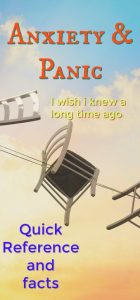Panic and Anxiety
In many cases, panic attacks strikeout of the blue, without any warning. Often, there is no clear reason for the attack. They may even occur when you’re relaxed or asleep. A panic attack is a sudden surge of overwhelming anxiety and fear. Your heart pounds and you can’t breathe. You may even feel like you’re dying or going crazy. They may even cause you to withdraw from normal activities. But panic attacks can be cured and the sooner you seek help, the better. With treatment, you can reduce or eliminate the symptoms of panic and regain control of your life.
A panic attack may be a one-time occurrence, but many people experience repeat episodes. Recurrent panic attacks are often triggered by a specific situation, such as crossing a bridge or speaking in public—especially if that situation has caused a panic attack before. Usually, the panic-inducing situation is one in which you feel endangered and unable to escape. When panic and anxiety symptoms escalate into anxiety attacks and panic attacks, it may be an anxiety disorder. Anxiety disorders include generalized anxiety disorder, social anxiety, and panic disorder. Anxiety attacks and panic attack symptoms can be treated with medication and psychotherapy.

You may experience one or more panic attacks, yet be otherwise perfectly happy and healthy. Or your panic attacks may occur as parts of another disorder, such as panic disorder, social phobia, or depression. Regardless of the cause, panic attacks are treatable. There are many effective treatments and coping strategies you can use to deal with the symptoms. Left untreated, panic attacks can lead to panic disorder and other problems.
Signs of Panic Disorder
The first step in treating a disorder is recognizing that something is not right. The second step is getting help. These two steps may, in fact, be the hardest part of the entire healing process. Once you seek help from a qualified health care provider, a correct diagnosis can be made and proper treatment can be given to help you get back on track.
Early recognition and treatment of panic and or anxiety disorders will offer the greatest chance of recovery and the earlier you seek to help the greater the chance that recurrences can be prevented.
Anxiety and Panic Disorder Therapy
There are many types of treatment when it comes to treating behavior disorders. That is good news, is that not one size fits all. Social treatment aims to change the participants’ attitude regarding the negative feelings. This can involve coping skills, working around high-risk situations and avoiding triggers. Of course, avoiding substance abuse is at the top of the list. Controlling cravings can go a long way in teaching a person practical ways to live life. Facing life challenges without the aid of a substance can be taught. A few therapies also work on increasing motivation and confidence. Another helpful tool is helping folks alter their environment. Other therapies focus on helping participants alter their circle of trust in order to reduce pressure and temptation to use.
Self-care
Avoid alcohol: May be harmful and aggravate certain conditions.
Reduce caffeine intake: Reduces risk of aggravating certain conditions.
Physical exercise: Aerobic activity for 20-30 minutes 5 days a week improves cardiovascular health. If injured, pursuing an activity that avoids the injured muscle group or joint can help maintain physical function while recovering.
Stress management: Pursuing an enjoyable activity or verbalizing frustration to reduce stress and improve mental health.
Smoking cessation: Quitting smoking tobacco.
Relaxation techniques: Deep breathing, meditation, yoga, rhythmic exercise, and other activities that reduce symptoms of stress
Healthy diet: A diet that provides essential nutrients and adequate calories, while avoiding excess sugar, carbohydrates, and fatty foods.Panic and Anxiety Disorder Quick Facts
Avoid alcohol: May be harmful and aggravate certain conditions. Reduce caffeine intake: Reduces risk of aggravating certain conditions.
Panic and Anxiety Disorder Quick Facts
A mental health disorder characterized by feelings of worry, anxiety, or fear that are strong enough to interfere with one’s daily activities. Very common More than 3 million US cases per year Treatable by a medical professional Usually self-diagnosable Lab tests or imaging not required Examples of anxiety disorders include panic attacks,
Very common: More than 3 million US cases per year Treatable by a medical professional Usually self-diagnosable Lab tests or imaging not required Examples of anxiety disorders include panic attacks,
More than 3 million US cases per year Treatable by a medical professional Usually self-diagnosable Lab tests or imaging not required Examples of anxiety disorders include panic attacks, obsessive-compulsive disorder, and post-traumatic stress disorder. Symptoms include stress that’s out of proportion to the impact of the event, inability to set aside a worry and restlessness. Treatment includes counseling or medications, including antidepressants.
Quick Reference
Medications
[sixcol_one][/sixcol_one] [sixcol_four]
[/sixcol_four] [sixcol_one_last][/sixcol_one_last]
Source and downloadable anxiety disorder file
Opinion and Bottom Line